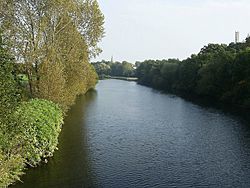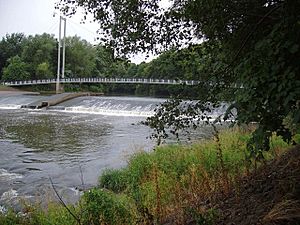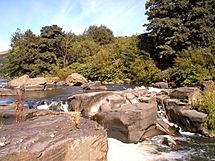River Taff facts for kids
Quick facts for kids River Taff |
|
|---|---|

The Taff flowing through Llandaff
|
|
| Native name | Afon Taf |
| Country | Wales |
| Historic county | Glamorgan |
| Unitary Authority | Merthyr Tydfil, Rhondda Cynon Taf, Cardiff |
| Settlements | Merthyr Tydfil, Treharris, Pontypridd, Cardiff |
| Physical characteristics | |
| Main source | Cefn-coed-y-cymmer, Merthyr Tydfil, Wales |
| Length | 67 km (42 mi) |
| Discharge (location 2) |
|
| Basin features | |
| Tributaries |
|

The River Taff (Welsh: Afon Taf) is an important river in Wales. It starts as two separate rivers in the Brecon Beacons. These are the Taf Fechan (meaning little Taff) and the Taf Fawr (meaning great Taff). They join together just north of Merthyr Tydfil. The river then flows south and eventually meets the River Severn estuary in Cardiff.
The Taff is home to several types of migratory fish. These include salmon, sewin (which are sea trout), and eel. These fish travel up and down the river to lay their eggs.
Contents
The River's Journey
The River Taff begins where the Taf Fechan and Taf Fawr rivers meet at Cefn-coed-y-cymmer. From there, it flows south through several towns. Along its journey, it collects water from other rivers that join it. These include the River Cynon, River Rhondda, Bargoed Taf, and Nant Clydach.
The river passes through Pontypridd and then reaches Taff's Well. This place is special because it has Wales' only natural warm spring. The Taff then flows under the M4 motorway. After that, it turns southeast. It goes past many suburbs of Cardiff, like Radyr, Whitchurch, Llandaff, and Pontcanna. Finally, it flows through the city centre and Grangetown. The river then empties into Cardiff Bay, close to where the River Ely also meets the bay.
The Taf Fawr Branch
The Taf Fawr starts high up, below the peak of Corn Du. This is southwest of Pen y Fan, a famous mountain. It flows south through a valley with steep sides. In 1881, engineers decided this valley was the best place to get water for the growing town of Cardiff.
To get this water, the Cardiff Corporation built three large reservoirs. The first one, Cantref Reservoir, was finished in 1892. Then, Beacons Reservoir, the highest one, was completed in 1897. The last one, Llwyn-on Reservoir, was much larger and finished in 1927. These reservoirs were very important for supplying clean water to Cardiff.
Below Llwyn-on, the river is crossed by major roads like the A470 and A465. It also passes the Cefn Railway Viaduct. This viaduct is a very old and important railway bridge. It was built with bricks because of a strike by stone workers in 1866. Near here, you can also see the remains of an old water channel, called a leat. It was built in 1766 to bring water to the Cyfarthfa Ironworks, which was a big factory in the past. The Taf Fawr then joins the Taf Fechan near Cyfarthfa Castle.
The Taf Fechan Branch
The Taf Fechan starts just south of Pen y Fan. It flows south through three reservoirs and one old, unused reservoir. This branch of the river was used to supply water to Merthyr Tydfil.
The Lower Neuadd Reservoir was built first, finishing in 1884. The Upper Neuadd Reservoir, which is bigger, was completed in 1902. It is one of the few artificial lakes built so high up in the mountains. The dams for these reservoirs are impressive structures.
The river continues south through a wooded valley. It passes under an old bridge called Pont Cwmyfedwen. Then it reaches Pentwyn Reservoir, which is the oldest of these reservoirs. It was built in the 1860s. However, it had problems with water leaking because it was built over a crack in the ground.
To help with the leakage, Pontsticill Reservoir was built. Construction started in 1913 but was delayed by the First World War. It was finally opened in 1927. This reservoir is very large and important for water supply. Its valve tower, which controls water flow, looks like an old castle tower.
Below Pontsticill, the river enters a wooded gorge. It is crossed by the seven-arched Pontsarn Viaduct, another old railway bridge built in 1866. Further south, the river plunges into a pool called Pwll Glas, or the Blue Pool. As it gets closer to Cefn-coed-y-cymmer, you can see more historical features. These include an old tramway and another leat. The tramway was used to carry limestone, and the leat supplied water to the Cyfarthfa Ironworks. The Taf Fechan then joins the Taf Fawr, forming the main River Taff.
The Taf Fechan is home to many wild brown trout. In 2006, there was an accident where a chemical spilled into the river from a water treatment plant. This pollution sadly killed about 23,000 fish, including trout, bullheads, and sticklebacks. Experts estimated it would take many years for the river to fully recover. Luckily, by 2009, the trout population had started breeding again.
The River Below the Confluence
Just after the Taf Fawr and Taf Fechan join, the river flows under the Pont-y-Cafnau bridge. This bridge is very special because it was probably the first iron railway bridge ever built. It had three levels: one for a railway, and two for carrying water. The iron for the bridge was made at the Cyfarthfa Ironworks, which was once the biggest ironworks in the world.
The river then flows through the western part of Merthyr Tydfil. Here, it is crossed by modern roads and an old bridge called Jackson's Bridge. This bridge used to carry a tramway and a road. Further south, the river is joined by Nant Rhyd-y-car.
As the river continues, a railway line runs alongside it. It passes through places like Troed-y-rhiw and Aberfan. Below Aberfan, the river enters a wooded area. Here, you can still see parts of the old Merthyr Tramroad. This tramroad is famous because it was where the world's first passenger train journey took place in 1804, pulled by Richard Trevithick's steam engine.
The river is crossed by several old bridges, including Pont y Gwaith, which has a date plaque from 1811. It also flows in a big loop around Goitre-Coed. Three historic bridges cross this loop. One was built by the famous engineer Isambard Kingdom Brunel in 1840-41 for the Taff Vale Railway. Another was part of the Merthyr Tramroad and was rebuilt in 1815.
Further south, the Taff is crossed by more roads. At Abercynon, the Afon Cynon joins the Taff. The valley then gets wider, and the river starts to curve more. The Nant Clydach joins the river near Glyncoch.
One notable bridge is White or Berw Bridge, built in 1907. It was a very modern design for its time, using reinforced concrete. The next important crossing is Pontypridd Bridge. This famous high-arched bridge was built in 1756 by William Edwards. It was his third attempt after his first two bridges collapsed. It has unique round openings in its sides to help support the wide arch.
On the east bank of the river in Pontypridd is Ynysangharad Park. This park has an old outdoor swimming pool, called a lido, built in 1923. It's an important historical building. On the west bank, the Afon Rhondda joins the Taff. The river then makes a big bend. It is crossed by Machine Bridge, also known as Pont y Doctor. This bridge was built in 1809 as part of a tramway to carry coal. It's thought to be one of the oldest multi-span railway bridges still existing.
Further downstream, there is a large, curved weir. This weir was built in 1834-5 to provide water power for the Treforest Tinplate Works. A fish ladder was added in 2003 to help fish travel upstream past the weir.
River Diversion in Cardiff
In the 1840s, when the South Wales Railway was planning a train station in Cardiff, the area was often flooded. The main path of the Taff used to go around Cardiff Castle and down what is now Westgate Street. The land where Cardiff Arms Park and the Principality Stadium now stand was often covered by tides.
The engineer Isambard Kingdom Brunel came up with a clever solution. He decided to move the Taff River further west. This created a larger and safer area for the new train station, which opened in 1850.
Rivers Joining the Taff
The River Taff has several smaller rivers and streams that flow into it. These are called tributaries.
Nant Ffrwd

Underneath the Cefn Coed Viaduct, the Nant Ffrwd joins the Taf Fawr. This tributary flows from a deep, wooded gorge.
Nant Morlais and Nant Rhydycar
As the Taff flows through the centre of Merthyr Tydfil, it is joined by the Nant Morlais. This stream comes out from an underground pipe on the east bank. A little further south, the Nant Rhydycar also joins the Taff.
Taff Bargoed, Cynon, Nant Clydach and Rhondda
South of Merthyr, the Taff winds its way through towns like Pentrebach, Abercanaid, Troed-y-rhiw, Merthyr Vale, and Aberfan. Near Quakers Yard, the Taff Bargoed and Nant Mafon rivers join the Taff. Then, in Abercynon, the Afon Cynon merges with the Taff. A bit further downstream, the Nant Clydach joins. Finally, at Pontypridd, the Afon Rhondda flows into the Taff. From Pontypridd, the Taff flows south until it reaches the city of Cardiff.
Where the Taff Meets the Sea

In Cardiff, the river's path was changed in the 1800s. Instead of flowing around Cardiff Castle, it now follows an artificial path to the west. This path takes it through Bute Park, past the Cardiff Arms Park, and the Principality Stadium. The Taff then flows into Cardiff Bay. This bay is an artificial lake created by building the Cardiff Bay Barrage in the 1990s. From Cardiff Bay, the Taff's waters finally flow into the Severn Estuary and then out to sea.
The Word "Taffy"
Sometimes, the word "Taffy" is used as a nickname for a Welsh person. Some people mistakenly think this word comes from the River Taff. It might have led to people from the Mid Glamorgan Valleys, where the Taff flows, being called "Taffy" or "Taffs."
However, the word "Taffy" actually comes from a different origin. It is a changed version of the Welsh name Dafydd, which is like the English name David. In the past, during wars, people sometimes used a single name to refer to all people from an enemy group. This was a way to make them seem less human. So, "Taffy" is similar to other old English nicknames like "Paddy" for Irish people or "Jock" for Scottish people.
The term is sometimes used as a nickname within the British army for Welsh soldiers or units, especially the Welsh Guards. However, the guardsmen themselves reportedly do not use this term.
See also
 In Spanish: Río Taff para niños
In Spanish: Río Taff para niños



